수두(작은 마마, 소두) Chickenpox
수두(작은 마마, 소두)의 원인
-
수두–대상포진바이러스(Varicella-zoster infections) 감염으로 생기는 전신 급성 바이러스성 감염병을 수두라고 한다.
-
수두를 왜 마마, 작은 마마, 소두라고도 부른다.
-
대상 포진 참조.
-
수두–대상 포진 바이러스는 대상 포진이란 감염병도 일으킨다.
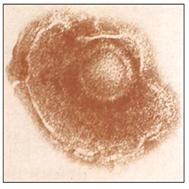
그림 3-25. 대상 포진 바이러스
출처:CDC/Dr. Erskin Palmer/B.C Partin
-
여기서는 수두–대상 포진 바이러스를 편의상 수두바이러스라고 한다.
-
수두는 야생 수두바이러스 감염으로 생긴 ‘자연 수두‘와 생 수두 예방접종 백신에 든 백신 수두바이러스 감염으로 생긴 ‘예방 접종 백신 수두‘
-
예방접종을 받았으나 수두바이러스 면역체가 체내에 제대로 생성되지 않아 체내 수두 면역체가 하나도 없을 때 감염되어 생긴 무면역체로 생긴 수두,
-
예방접종을 받아 수두바이러스 면역체가 체내에 한때는 충분히 있었으나 그 수두 면역체의 양이 점점 감소되어 수두 바이러스 감염을 예방하기에는 충분치 않은 상태에 있을 때 수두 바이러스에 감염되어 생긴 ‘예방접종 후 수두‘ 등으로 나눌 수 있다.
-
여기서는 자연 수두에 관해 주로 설명하기로 한다.
-
자연 수두를 한 번 앓은 후 또다시 수두를 앓지 않는 것으로 알고 있지만 자연 수두를 과거에 한 번 앓았던 사람에게 무 활동 상태 야생 수두바이러스가 있을 수 있다. 무 활동 상태 수두 바이러스에 감염되면 대상 포진 감염병이 생길 수 있다.
-
무활동 상태로 있던 야생 수두바이러스가 신체의 말초신경에 감염될 수 있고 그 말초신경이 분포된 피부절(피부판)에도 감염될 수 있다.
-
그래서 수두 바이러스성 피부 발진이 피부절에 생기고 말초신경 주행에 따라 수두 말초신경염이 생길 수 있다.
-
이렇게 생긴 자연 수두 바이러스성 피부 절과 말초 신경 감염병을 대상 포진이라고 한다.
-
([부모도 반의사가 되어야 한다–소아가정간호백과]-제17권 소아청소년 피부질환을 참조한다.)

그림 3-24. 수두의 전형적 증상
Reproduced with permission from Saul Krugman, Samuel L.Katz, Anne A. Gershon, Catherine Wilfert : Infectious diseases of Children, 8th Edition 1985, St. Louis, The C. V. Mosby Co. 및 부모도 반의사가 되어야 한다 소아가정간호백과
-
수두 바이러스는 감염력이 상당히 강해 과거에 자연 수두를 한 번도 앓은 병력이 없는 아이들이나 성인들은 일생동안 자연 수두에 적어도 한 번 꼭 걸릴 수 있다.
-
자연 수두를 앓는 환자가 기침이나 재채기를 할 때나 말 할 때 환아로 부터 나온 수두바이러스에 근접해 있는 아이들이나 성인들이 감염되어 자연 수두에 걸릴 수 있다.
-
임신되기 전 자연 수두를 앓았거나 수두백신으로 접종 받았던 임신부에게 태어난 신생아들은 출생 전 모체로부터 수두 면역체를 얻어가지고 태어난다. 그런 이유로, 생후 첫 6개월 동안은 수두에 잘 걸리지 않는 것이 보통이다.
-
그러나 자연 수두를 한 번도 앓지 않은 병력이 있는 임신부로부터 태어난 아기는 생후 언제든지 수두에 걸릴 가능성이 있다.
-
임신 첫 3개월 동안에 임신부가 풍진에 걸리면 태아에게 선천성 풍진 증후군이 생길 수 있고 임신부가 수두에 걸리면 태아에게 선천성 수두 증후군이 생길 수 있다.
-
선천성 수두 증후군에 걸리면 반흔성 피부 변형, 근위축, 눈에 선천성 기형, 뇌 피질 위축 등 여러 종류의 선청성 수두 기형이 생길 수 있다.
수두(작은 마마/소두)의 증상 징후
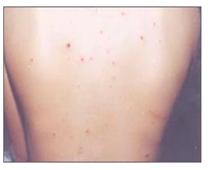
사진 3-27. 등에 난 자연 수두 발진
Copyright ⓒ 2011 John Sangwon Lee, MD., FAAP
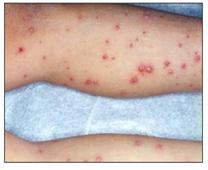
사진 3-28.1 아래다리에 난 자연 수두 발진
Copyright ⓒ 2011 John Sangwon Lee, MD., FAAP
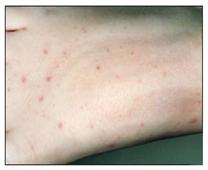
사진3-29.2 발 등에 난 자연 수두 발진
Copyright ⓒ 2011 John Sangwon Lee, MD., FAAP
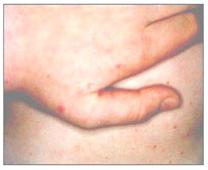
사진 3-30. 손등에 난 자연 수두 발진
Copyright ⓒ 2011 John Sangwon Lee, MD., FAAP
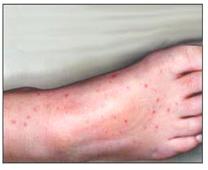
사진3-32.발에 난 자연 수두 발진
Copyright ⓒ 2011 John Sangwon Lee, MD., FAAP
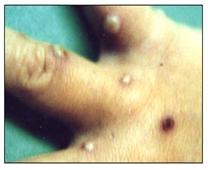
사진 3-35. 손등에 난 자연 수두 발진이 곪았다
Copyright ⓒ 2011 John Sangwon Lee, MD., FAAP

사진 3-36. 심한 자연 수두 발진과 물 사마귀
Copyright ⓒ 2011 John Sangwon Lee, MD., FAAP
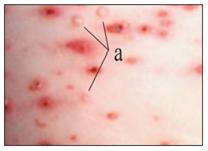
사진 3-37. 자연 수두 발진과 감염성 연속종(물사마귀)
Copyright ⓒ 2011 John Sangwon Lee, MD., FAAP
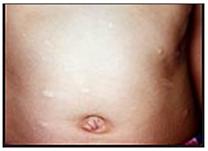
사진 3-38. 수두 발진이 나은 후 생긴 하얀 상흔 반점
Copyright ⓒ 2011 John Sangwon Lee, MD., FAAP
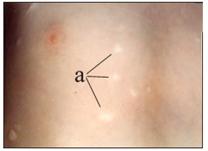
사진 3-39. 수두 발진이 나은 후 생긴 하얀 상흔 반점)
Copyright ⓒ 2011 John Sangwon Lee, MD., FAAP
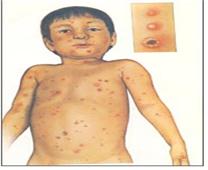
그림 3-40. 자연 수두의 피부 발진
Reproduced with the permission from Ross Lab.
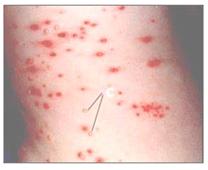
사진 3-37.자연 수두 발진과 감염성 연속종(물사마귀)
Copyright ⓒ 2011 John Sangwon Lee, MD., FAAP

사진 3-31. 배에 난 자연 수두 발진
Copyright ⓒ 2011 John Sangwon Lee, MD., FAAP
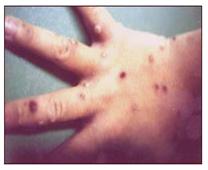
사진 3-34. 손에 난 심한 자연 수두 발진
Copyright ⓒ 2011 John Sangwon Lee, MD., FAAP
-
수두는 야생 수두 바이러스로 생긴 자연 수두와 수두 예방접종 백신 속에 든 생 수두바이러스로 인한 “예방접종 백신 수두“와 예방접종을 받은 후 수두 면역체가 감소되거나 없어질 때 생기는 “예방 접종 후 수두“가 있다.
-
여기서는 자연 수두에 관해 주로 설명하기로 한다.
-
환자의 나이, 수두 예방접종을 받았는지 안 받았는지, 에이사이클로비어(Acyclovir/Zovirax) 등 항 바이러스제로 치료를 받고 있는지, 2차 박테리아 감염으로 생긴 합병증의 유무 등에 따라 자연 수두의 증상 징후가 다르다.
-
수두 예방접종을 받지 않은 아이에게 생긴 자연 수두의 전형적인 증상 징후는 다음과 같다.
-
자연 수두의 초기의 증상 징후는 감기의 증상 징후와 거의 비슷한 데가 있다.
-
콧물이 나고, 인두가 아프며, 미열이나 고열이 난다.
-
이런 증상 징후가 시작된 지 1, 2일이 지나면 가슴, 등, 배 부위 피부에 붉은 수두 피부 발진이 나기 시작한다.
-
피부 발진이 처음 나기 시작할 때는 피부 표면과 거의 같은 레벨로 납작하게 드문드문 난다.
-
그 후 납작하게 났던 피부 발진이 피부 표면 위로 점점 더 솟아나서 그 발진이 구진이 된다. 각 구진의 크기는 쌀알만큼 큰 것도 있고 콩알만큼 큰 것도 있다.
-
그 후 구진 속에 체액이 잡혀 구진이 수포가 되고, 수포 속에 있는 체액이 탁한 고름으로 변해서 수포가 농포로 변한다(그림 3-40 참조).
-
그 후 농포가 3, 4일 지나면 말라서 부스럼 딱지 즉 가피가 된다.
-
이 부스럼 딱지가 말라 떨어지면서 수두는 낫는다.
-
이런 수두의 피부 발진이 나기 시작해서 다 없어질 때까지 7~10일 정도 걸린다.
-
마마를 앓을 때 생기는 피부 발진과는 달리, 수두 피부 발진은 나은 후 흉터가 현저히 생기지 않는 것이 보통이다.
-
수두의 초기에는 수두 피부 발진이 주로 가슴과 배 즉, 몸통 부분에서 나기 시작하다가 수두가 점점 더 진행되면서 총 250~300여개의 수두 발진이 팔, 다리, 얼굴 등으로 점점 더 퍼져 난다.
-
수두 발진이 결막, 비강, 인두, 기도, 외부 생식기 등의 점막에도 날 수 있다.
-
자연 수두의 발진으로 가려워서 많이 긁을 수 있다.
-
이 때 긁어서 생긴 상처를 통해 2차 박테리아 감염이 생겨 농가진, 종기, 림프절염, 패혈증, 골수염 등 여러 종류의 2차 박테리아 감염병 등이 생길 수 있다.
-
앞서 설명한 증상 징후 이외 두통, 복통, 전신권태, 식욕감퇴, 근육통 등이 생길 수 있다.
-
미열 내지 섭씨 39도 정도 고열이 날 수 있고 때로는 열성경련을 할 수 있다.
-
자연 수두를 앓는 중 수두 바이러스성 감염으로 인해 뇌염, 간염, 폐렴, 출혈성 수두, 만성 수두, 관절염, 뇌막염, 사구체 신염 등 수두 바이러스성 감염병이 생길 수 있다.
-
라이 증후군 등이 생길 수 있다.
-
잠복기는 약 10~21일이고 자연 수두를 앓는 임신부에게 태어난 신생아의 수두는 출생 후 1~16일 경에 발생할 수 있다.
수두(작은 마마/소두)의 진단
-
병력, 증상 징후, 진찰소견 등을 종합해서 수두를 비교적 쉽게 진단할 수 있다.
-
이 병의 초기에는 미열, 전신권태, 식욕감퇴, 인두통 등 감기의 증상 징후와 거의 비슷한 증상 징후가 생길 수 있고 때로는 수두를 앓는지 감기를 앓고 있는지, 벼룩 등 벌레에 물린 피부염, 옴 피부염 등 다른 종류의 피부병을 앓는지 확실히 감별 진단하기가 곤란할 때도 있다.
-
수두의 피부 발진이 몸통에 드문드문 나기 시작할 때부터는 진단하기가 비교적 더 쉽다.
-
앞서 설명한 것과 같이 수두 발진의 대부분은 홍반→ 구진→ 수포→ 농포→가피 순으로 진행되는 과정을 거쳐 결국에는 낫는다.
-
수두를 앓을 때 이런 여러 종류의 피부 발진이 동시 날 수 있는 것이 수두발진의 특징이기도 하다([부모도 반의사가 되어야 한다–소아가정간호백과]-제17권 소아청소년 피부질환–곤충 물림, 옴 참조).
-
이런 수두의 피부 발진이 났다가 없어질 때까지의 과정을 잘 관찰해 수두를 쉽게 진단할 수 있다.
-
수두 바이러스는 감염력이 강하기 때문에 수두가 어떤 지역에 한 번 유행되면 그 지역에서 사는 몇 몇 아이만 수두에 걸리는 것이 아니라 그 지역에서 사는 거의 모든 아이들이 수두에 다 걸려 앓는 것을 자주 볼 수 있다.
-
이와 같이 이웃집 아이들이 수두에 걸려 앓으면 수두를 진단하는 데 큰 도움이 된다.
- 상기도 부분의 비강, 인두 등에서 나오는 점액, 기침할 때 뱉는 가래, 피부 발진에서 채취한 점액 피고름 등 피검 물로 수두 바이러스를 배양 검사하여 진단할 수 있다.
- 수두의 피부 발진에서 채취한 생체조직 검사 짱크 검사(Tzanck test)와 현미경 검사로 진단할 수 있고, 자연 수두 바이러스를 배양하거나 수두바이러스 IgG 항체검사, 효소연결면역 흡착측정법(ELISA), 보체 결합시험(CFT), LA, IFA, FAMA 등 여러 종류의 피 검사로 진단할 수 있다.
-
이런 복잡한 여러 종류의 검사를 하는 데는 시간과 경비가 많이 들고 특수한 시설이 필요로 하기 때문에 병력, 증상 징후, 진찰소견 등을 종합하여 수두를 진단하는 것이 보통이다.
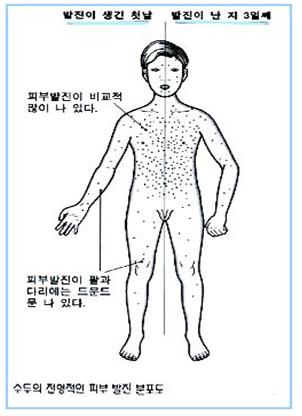
그림 3-41. 전형적 수두의 전형적 피부 발진의 분포도
Used with permission from Infectious diseases of children, 8th edition.The C.V Mosby Co. Saul Krugman, Samuel L Katz and others
수두(작은 마마/소두)의 치료
-
자연 수두를 앓을 때 농가진, 화농성 관절염, 화농성 골수염 등 2차 박테리아 감염에 의한 합병증의 유무, 수두바이러스 감염으로 인한 국소성 괴저, 수두바이러스성 뇌염, 수두바이러스성 신경염, 수두 바이러스성 사구체 신염, 수두바이러스성 심근염 등 수두바이러스성 합병증이 생기지 않으면 대개 10일 정도 앓다가 자연적으로 낫는 것이 보통이다.
-
가렵고 열이 나고 전신이 아프고 인두통 등의 증상 징후는 타이레놀 등으로 해열과 진통을 시켜 대증 치료한다.
-
수두를 앓을 때 아스피린으로 치료하면 라이 증후군이 생길 수 있으므로 아스피린으로는 치료하지 않는다.
-
다른 종류의 급성 바이러스성 감염병을 앓을 때와 마찬가지로 수두를 앓을 때도 며칠 동안은 잘 먹지 않는 것이 보통이다.
-
식욕이 없을 때는 고기국물, 과일주스 등 전 유동음식물 또는 반 유동음식물을 조금씩 자주 주어 탈수를 예방 치료 하고 영양가 음식물을 충분히 보충해 주고 잘 먹고 마실 수 있으면 보통 먹던 음식물을 주기 시작한다.
-
이 병이 다 나을 때까지 우유나 우유가 든 음식물을 될 수 있는 한 주지 않는 것이 좋다.
-
모유나 인공영양을 먹는 영아에게 수두가 생길 때는 모유나 인공영양을 계속 먹여도 된다.
-
그러나 유당이나 우유 단백질이 든 인공영양을 먹고 설사를 할 수 있으므로 주의해야 한다.
-
수두 피부 발진으로 인해 가려우면 타이레놀 및. 또는 베나드릴 등 항히스타민제로 대증 치료할 수 있다. 그밖에 어떤 종류의 로션이나 크림을 발라줄 필요가 없다.
-
수두 피부 발진이나 긁어서 생긴 피부 상처를 통해서 2차 박테리아 감염이 생겨 농가진, 종기, 림프절염 등의 합병증이 생길 수 있다.
-
수두를 앓을 때와 2차 박테리아 감염 등의 합병증이 생길 때는 증상 징후, 진단, 치료가 수두만 앓을 때의 증상 징후, 진단, 치료와 다른 점이 많다.
-
모든 수두 피부 발진에 딱지질 때까지 집에서 안정을 취하고 쉬는 것이 좋다. 그렇다고 해서 가만히 누워서 안정을 취할 필요는 없다.
-
경구용 에이사이클로비아(Acyclovir) 항 바이러스제로 초기 수두를 치료하면 치료 효과가 있으나 아직 이 약으로 모든 자연 수두를 통상적으로 치료하라고 권장하지는 않는다.
-
이에 대해 의사에게 문의한다. 자연 수두를 심하게 앓을 때나 다른 병으로 인해서 자연 수두를 더 심하게 앓을 가능성이 있는 아이의 초기 수두는 에이사이클로비아제로 치료하기도 한다. 에이사이클로바이 이외 Valtrex(Valacylovir hydrchloride)로 2~18세 소아청소년들의 수두를 치료할 수 있다. 참고로 12세와 그 상 소아청소년들의 입술 헤르페스(콜드 소아)도 이 항바이러스제로 치료할 수 있다.
수두(작은 마마/소두)환자의 격리
-
자연 수두 피부 발진이 나기 시작한 날부터 7일 동안 격리시킨다.
-
모든 피부 발진이 마른 딱지로 변할 때까지 수두 바이러스가 다른 사람에게 감염될 수 있다.
-
따라서 수두 피부 발진이 딱지가 지기까지는 수두를 앓는 아이들을 수두 바이러스에 면역이 되지 않은 다른 아이들이나 성인들과 접촉시키지 말고 학교에도 보내지 말아야 한다.
수두(작은 마마/소두)환아와 접촉한 경우
-
수두 백신으로 배열 예방 접종을 받았던 건강한 아이들은 수두 환자와 직접 접촉했더라도 예방접종을 특별히 해 줄 필요는 없다. 과거에 수두를 한 번 앓은 아이들은 수두에 또다시 걸리지 않는 것이 보통이다.
-
코르티코스테로이드제로 어떤 병을 장기간 치료받는 아이,
-
암이나 백혈병 등을 치료하기 위해 항암제로 치료 받는 아이,
-
방사선 치료를 받는 아이,
-
면역체 감소증이나 면역체 결핍증이 있는 아이가 과거에 자연 수두를 앓은 병력이 있어도 또다시 수두에 걸릴 수 있고, 또 수두에 걸리면 심하게 앓거나 사망할 수 있을 정도로 위험성이 많다.
-
따라서 이런 병을 앓는 아이가 수두 환자와 접촉됐을 때는 대상 포진 면역 글로불린 등으로 수두를 수동 면역 치료를 해 주어야 한다.
수두(작은 마마/소두) 예방접종
-
수두 백신에는 수두를 앓는 환자에서 채취한 야생 수두 바이러스를 인공적으로 배양한 후 수두 바이러스 균독을 감독시켜 만든 단가 생 수두 백신이 있고,
-
수두 백신, 홍역 백신, 유행성 이하선염 백신과 풍진 백신이 든 프로쿠아드(ProQuad) 종합 백신이 있다.
-
이 네 가지 바이러스에 의한 감염병을 예방할 수 있는 ProQuad 백신으로 1차 예방접종을 받고 4~6세에 2차 예방접종을 받는다.
수두(작은 마마/소두) 백신 접종연령
-
수두 백신을 접종 받을 수 있는 최소 연령은 생후 12개월이다.
-
생후 12~18개월에 수두 백신으로 1회 피하주사로 1차 접종을 받고 생후 4~6세에 2차 접종을 받는다.
-
13세 이전 소아들이 처음으로 수두 백신으로 접종 받을 때는 1차 수두 백신으로 접종 받은 후 3개월 될 때 2차 수두 백신으로 예방접종을 받도록 권장한다.
-
13세 이후 사춘기 아이가 처음으로 수두 백신으로 예방접종을 받을 때는 1차 수두 예방접종을 받은 후 4주 간격을 두고 2차 수두 예방접종을 받도록 권장한다.
-
수두 백신, 홍역 백신, 유행성 이하선염 백신, 풍진 백신이 든 프로쿠아드(ProQuad) 종합 백신으로 생후 12~18개월에 1차 예방접종을 받아 수두, 홍역, 유행성 이하선염, 풍진 등 네 가지 바이러스로 인한 감염병을 예방할 수 있고 필요에 따라 ProQuad 백신으로 2차 예방접종을 받을 수 있다.
-
수두 백신으로 예방접종을 받을 때의 수두 백신 예방접종의 면역 효과는 96~100% 정도이다.
-
([부모도 반의사가 되어야 한다–소아가정간호백과]-제2권 소아청소년 질병 및 안전사고 예방–수두와 대상포진 참조).
-
제2권 소아청소년 질병 및 안전사고 예방-2013년 1월 미 CDC, 소아청소년과 학회 등에서 권장하는 소아 예방접종 스케줄의 표 참고한다.
미 0~18세 소아청소년 기본 예방접종 Recommended immunization schedule for 0~18 year old Americal children
|
☞ 각 나라에 따라 권장 기본 예방접종 스케줄이 다를 수 있다. |
권장 미 0~18세 소아청소년 기본 예방접종 스케줄과 표 1A
Recommended immunization schedule for persons aged 0 through 18 years
| 예방접종 백신 종류/ 예방해 주는 감염병 | 출생 후 바로 | 생후 1개월 |
생후 2개월 |
생후 4개월 |
생후 6개월 |
생후 9개궐 |
생후 12개월 |
생후 15개월 |
생후 18개월 |
생후 19~23개월 |
생후 2~3세 |
생후 4~6세 |
생후 7~10세 |
생후 11~12세 |
생후 13~15세 |
생후 16~18세 |
||||||
| Hepatitis B¹ (HepB) /b 형 간염 | ←1차 접종 | ←2차 접종→ | ←3차 접종→ | |||||||||||||||||||
| Rotavirus²(RV) RV-1(2회분 배열 접종); RV-5(3 회분 배열 접종)/ 로타바이러스 감염병 | ←1차 접종→ | ←2차 접종→ | 각주 2 | |||||||||||||||||||
| Diphtheria, Tetanus, acellular Pertussis³(DTaP;<7세)/파상풍, 디프테리아, 백일 해 | ←1차 접종→ | →2차 접종→ | ←3차 접종→ | ←4차 접종→ | ←5차 접종→ | |||||||||||||||||
| Tetanus, Diphtheria, acellular Pertussis⁴ (DTap;7세나 >7세 파상풍, 디프테리아, 백일 해 | (Tdap) | |||||||||||||||||||||
| Haemophilus influenzae type b⁵(HIb)/ 히브 감염병 | ←1차 접종→ | ←2차 접종→ | 각주 5 | ←3차 또는 4차 접종 → 각주 5 | ||||||||||||||||||
| Pneumococcal conjugate⁶a, c (PCV13)/폐렴연쇄상구균 감염병 | ←1차 접종→ | ←2차 접종→ | ←3차 접종→ | ←4차 접종→ | ||||||||||||||||||
| Pneumococcal polysaccharide⁶bc (PPSV23) /폐렴연쇄상구균 감염병 | ||||||||||||||||||||||
| Inactivated Poliovirus⁷(IPV)(<18 세)/소아마비 | ←1차 접종→ | ←2차 접종→ | ←3차 접종→ | ←4차 접종→ | ||||||||||||||||||
| 예방 접종 백신 종류/예방해 주는 감염병 | 출생 후 바로 | 생후 1개월 |
생후 2개월 |
생후 4개월 |
생후 6개월 |
생후 9개궐 |
생후 12개월 |
생후 15개월 |
생후 18개월 |
생후 19~23개월 |
생후 2~3세 |
생후 4~6세 |
생후 7~10세 |
생후 11~12세 |
생후 13~15세 |
생후 16~18세 |
||
| Influenza⁸(IIV; LAIV) 1부에게는 2회분,각주 8 /인플루엔자 | ←매해 마다 접종 받는다 (11V 만)→ | ←매해 마다 접종 받는다 (II V 또는 LAIV)→ | ||||||||||||||||
| Measles, Mumps, Rubella⁹(MMR)/ 홍역, 풍진, 유행성 이하선염 | ←1차 접종→ | ←2차 접종→ | ||||||||||||||||
| Varicella ¹⁰ (VAR) /수두 | ←1 차 접종→ | ←2차 접종→ | ||||||||||||||||
| Hepatitis A¹¹ (HepA)/A형 간염 | ←2 회분→ 주서 11 | |||||||||||||||||
| (Human papillomavirus¹² (HPV2; 여성에게만 (HPV4; 여성과 남성 에게)/사람유두종 바이러스 감염병 | ←3회 분 배열 접종→ | |||||||||||||||||
| Meningococcal¹³ (MenACWY-D 생후 9 개월이나 그후후. MenACWY-CRM-D는 생후 2개월이나 그 이후. MenACWY-TT는 은 생후 2세나 그 이후. /수막구균 뇌막염과 그 외 감염병
—————————- Meningococcal B 백신에는 MenB-4C, Bexsero, MenB-FHbp, Trumenba 백신이 있다. 10세나 그 이상에 접조한다. Bexsero백신은 2회 접종하고 Trumenba 백신은 총 3회 접종한다. 위험도다 없는 사춘기아이들이나 청년들은 16-23세에 접종받는다. 소스: CDC, AAP News 3/2021 |
←주서 13→ | ←1차 접종→ | 추가 접종 | |||||||||||||||
|
|
접종을 권장 하는 나이의 범위, | ||
|
|
건강상 고 위험 군 아이들에게 접종을 권장하는 나이 |
수두(작은 마마, 소두) 백신 예방접종 방법
-
소아 정기 건강검진을 받고 열이 나는지 알아보기 위해 체온을 재고 발열성 감염병이 없고 체온이 정상이고 수두 예방접종 백신에 알레르기가 없고 접종에 금기사항이 없을 때는 예방접종을 받을 수 있다.
수두(작은 마마/소두)백신 예방 접종의 면역 효과
-
생후 1세에서부터 12세까지 단 1회 수두 예방접종을 1차 받은 후 수두와 대당포진 바이러스 감염에 95% 예방 면역효과가 있다.
-
생후 4~6세에 2차 예방접종을 추가로 한 번 더 받을 것을 권장한다.
-
13세나 그 이후 사춘기 아이들이 단 1차 수두 예방접종을 받은 후 수두와 대상 포진 바이러스 감염에 78~82% 예방 면역효과가 있고 2차 접종 후 99% 예방 면역효과가 있다.
수두(작은 마마/소두)백신 예방 접종의 부작용
-
수두 예방접종 백신을 주사로 접종받은 국소가 조금 붓고 아플 수 있다.
-
수두를 앓을 때 생기는 피부 발진과 비슷한 발진이 날 수 있고 미열 등의 증상 징후가 있는 수두를 경미하게 앓을 수 있다.
수두(작은 마마/소두)백신 예방 접종 금기
-
수두 예방접종 백신을 제조하는 과정에서 사용된 젤라틴이나 네오마이신 등에 알레르기가 있거나
-
선천적 면역체 결핍증 또는 후천적 면역체 결핍증이 있거나
-
에이즈를 앓거나
-
항암치료제로 치료를 받거나 코르티코스테로이드제로 치료 받거나 방사능 치료를 받거나
-
그 외
Chickenpox and shingles( Herpes zoster) 수두(작은 마마, 소두)와 대상포진
Causes of chickenpox
• A systemic acute viral infection caused by infection with Varicella-zoster infections is called chickenpox.
• Chickenpox is also called many other named
• See shingles.
• Varicella-zoster virus also causes an infectious disease called shingles.

Figure 3-25. Shingles virus Source: CDC/Dr. Erskin Palmer/B.C Partin
• Here, the varicella-zoster virus is referred to as the varicella-zoster virus for convenience.
• Chickenpox is a’natural chickenpox’ caused by a wild chickenpox virus infection and a vaccine from a live chickenpox vaccination’Vaccination vaccine chickenpox’ caused by a chickenpox virus infection.
• Chickenpox resulting from infection when immunized, but no chickenpox immune system is present in the body because the chickenpox virus immunity is not properly produced in the body,
• After vaccination, there was enough chickenpox virus in the body at one time, but the amount of chickenpox immune body decreased gradually, and when it was not enough to prevent chickenpox virus infection, it can be divided into’post-vaccinated chickenpox’, etc. I can.
• Here, we will mainly explain about natural chickenpox.
• You know that you won’t get chickenpox again after you have had it once, but people who have had it once in the past may have inactive wild chickenpox virus. Inactive chickenpox virus infection can lead to a shingles infection.
• Wild chickenpox virus, which has been inactive, can infect the peripheral nerves of the body and can also infect the dermatome (skin plate) where the peripheral nerves are distributed. • So, varicella viral skin rash occurs on the skin nodes, and varicella peripheral neuritis may develop depending on the peripheral nerve driving.
• These natural varicella viral cutaneous nodes and peripheral nerve infections are called shingles.
• (www.drleepediatrics.com-Refer to Child and Adolescent Skin Diseases in Volume 17).

Figure 3-24. Typical symptoms of chickenpox Reproduced with permission from Saul Krugman, Samuel L. Katz, Anne A. Gershon, Catherine Wilfert: Infectious diseases of Children, 8th Edition 1985, St. Louis, The C. V. Mosby Co.
And parents should also be anti-doctors. Child and Family Nursing Encyclopedia
• Chickenpox virus is highly infectious, so children and adults who have never had spontaneous chickenpox in the past can get spontaneous chickenpox at least once in their lifetime.
• When a person with spontaneous chickenpox coughs, sneezes, or speaks, children or adults who are close to the chickenpox virus from the patient can become infected and get spontaneous chickenpox.
• Newborns born to pregnant women who had natural chickenpox prior to conception or who were vaccinated with chickenpox vaccine are born with chickenpox immunity from their mother before birth. For that reason, it is common to be less susceptible to chickenpox during the first six months of life.
• However, babies born to pregnant women who have never had spontaneous chickenpox are likely to get chickenpox at any time after birth.
• If a pregnant woman gets rubella during the first three months of pregnancy, the fetus can develop congenital rubella syndrome, and if a pregnant woman gets chickenpox, the fetus can develop congenital chickenpox syndrome.
• Congenital chickenpox syndrome can lead to several types of congenital chickenpox anomalies, including scarring skin deformation, muscular atrophy, congenital anomalies in the eye, and atrophy of the brain cortex.
Symptoms signs of chickenpox

Photo 3-27. Spontaneous chickenpox rash on the back Copyright ⓒ 2011 John Sangwon Lee, MD., FAAP

Photo 3-28.1 Natural chickenpox rash on the lower leg Copyright ⓒ 2011 John Sangwon Lee, MD., FAAP Photo 3-29.2 Natural chickenpox rash on the back of the foot Copyright ⓒ 2011 John Sangwon Lee, MD., FAAP

Photo 3-30. Natural chickenpox rash on the back of the hand Copyright ⓒ 2011 John Sangwon Lee, MD., FAAP

Photo 3-32. Natural chickenpox rash on the foot Copyright ⓒ 2011 John Sangwon Lee, MD., FAAP

Photo 3-35. A spontaneous chickenpox rash on the back of my hand has festered. Copyright ⓒ 2011 John Sangwon Lee, MD., FAAP

Photo 3-36. Severe natural chicken pox rash and water warts Copyright ⓒ 2011 John Sangwon Lee, MD., FAAP

Photo 3-37. Spontaneous chicken pox rash and continuous infectious diseases (water warts) Copyright ⓒ 2011 John Sangwon Lee, MD., FAAP

Photo 3-38. White scarring spots after the chickenpox rash healed Copyright ⓒ 2011 John Sangwon Lee, MD., FAAP

Photo 3-39. White scars after the chickenpox rash healed) Copyright ⓒ 2011 John Sangwon Lee, MD., FAAP

Figure 3-40. Natural chickenpox skin rash Reproduced with the permission from Ross Lab.

Photo 3-37. Natural chickenpox rash and infectious series (water wart) Copyright ⓒ 2011 John Sangwon Lee, MD., FAAP

Photo 3-31. Spontaneous chickenpox rash on the stomach Copyright ⓒ 2011 John Sangwon Lee, MD., FAAP

Photo 3-34. Severe natural chickenpox rash on the hand Copyright ⓒ 2011 John Sangwon Lee, MD., FAAP
• Varicella is known as natural chickenpox caused by the wild chickenpox virus and “vaccinated chickenpox” caused by the live chickenpox virus contained in the chickenpox vaccine, and “chickenpox after vaccination”, which occurs when the chickenpox immune system decreases or disappears after vaccination. have.
• Here, we will mainly explain about natural chickenpox.
• Symptoms of natural chickenpox differ depending on the age of the patient, whether or not they have been vaccinated against chickenpox, are being treated with antiviral drugs such as Acyclovir/Zovirax, and whether there are complications from secondary bacterial infections.
• Typical symptoms of spontaneous chickenpox in a child who has not been vaccinated against chickenpox include:
• The initial symptoms of spontaneous chickenpox are almost the same as those of a cold.
• I have a runny nose, a sore pharynx, and a mild or high fever.
• One or two days after the onset of these symptoms, a red chickenpox skin rash begins to appear on the skin of the chest, back, and abdomen.
• When the skin rash first begins, it is flat and sparse at about the same level as the skin surface.
• After that, the flattened skin rash rises more and more above the surface of the skin, and the rash becomes a papule. Each papule is as large as a grain of rice and some as large as a grain of beans.
• After that, fluid is trapped in the papules and the papules become blisters, and the fluid in the blisters turns into turbid pus, and the blisters turn into pustules (see Figure 3-40).
• After that, after 3 or 4 days, the pustules dry up and become scabs or crusts. • Chickenpox heals as these scabs dry and fall.
• These chickenpox skin rashes start to appear and take 7 to 10 days for them to disappear.
• Unlike skin rashes that occur when suffering from mama, chickenpox skin rashes usually do not cause significant scarring after healing.
• In the early stages of chickenpox, chickenpox skin rashes begin to appear mainly on the chest and abdomen, that is, the torso. As chickenpox progresses more and more, a total of 250 to 300 chickenpox rashes spread more and more to the arms, legs, and face.
• Chickenpox rash can also spread to the mucous membranes of the conjunctiva, nasal cavity, pharynx, airways, and external genitals.
• Natural chickenpox rash, itchy, can scratch a lot.
• At this time, secondary bacterial infection can occur through the wound caused by scratching, which can lead to various types of secondary bacterial infections such as impetigo, boils, lymphadenitis, sepsis, and osteomyelitis.
• In addition to the above-described symptoms, headache, abdominal pain, general malaise, loss of appetite, and muscle pain may occur.
• You may have a mild to high temperature of 39 degrees Celsius and sometimes have febrile seizures.
• During spontaneous chickenpox, varicella viral infections can lead to varicella viral infections such as encephalitis, hepatitis, pneumonia, hemorrhagic chickenpox, chronic chickenpox, arthritis, meningitis, and glomerulonephritis.
• Reye syndrome, etc. may occur.
• The incubation period is about 10 to 21 days, and chickenpox in newborns born to pregnant women with spontaneous chickenpox can occur 1 to 16 days after birth.
Diagnosis of chickenpox
• Comprehensive medical history, symptoms, and examination findings makes it relatively easy to diagnose chickenpox.
• In the early stages of the disease, symptoms similar to those of a cold such as mild fever, general malaise, loss of appetite, and sore throat may occur. Sometimes, whether you have chickenpox or cold, dermatitis from insect bites such as fleas, scabies dermatitis, etc. There are times when it is difficult to clearly differentiate whether you are suffering from any kind of skin disease.
• It is relatively easier to diagnose from the time the skin rash of chickenpox begins to appear sparse on the torso.
• As described above, most of the chickenpox rashes go through the order of erythema → papules → blisters → pustules → crusts and eventually heal.
• It is also a characteristic of chickenpox rash that these types of skin rashes can occur simultaneously when suffering from chickenpox www.drleepediatrics.com-Vol. 17 Child and Adolescent Skin Diseases-Insect bites, scabies Reference).
• You can easily diagnose chickenpox by observing the process from which the skin rash of chickenpox occurs and disappears.
• Chickenpox virus is highly infectious, so once an outbreak in an area of chickenpox occurs, it is often seen that not only a few children living in that area get chickenpox, but almost all children living in that area get chickenpox.
• These children in the neighborhood are very helpful in diagnosing chickenpox if they have chickenpox.
• Chickenpox virus can be cultured and diagnosed with specimens such as mucus from the nasal cavity and pharynx in the upper respiratory tract, sputum when coughing, and mucous blood pus collected from skin rashes.
• Biopsy obtained from skin rash of chickenpox.
It can be diagnosed by Tzanck test and microscopic examination.
Natural chickenpox virus is cultured, chickenpox virus IgG antibody test, enzyme-linked immunosorbent assay (ELISA), complement binding test It can be diagnosed with several types of blood tests such as (CFT), LA, IFA, and FAMA.
• It is common to diagnose chickenpox by combining medical history, symptoms, symptoms, and examination findings, as it takes a lot of time and money to perform these complex types of tests, and requires special facilities.

Figure 3-41. Distribution of typical skin rashes of typical chicken pox Used with permission from Infectious diseases of children, 8th edition.The C.V Mosby Co. Saul Krugman, Samuel L Katz and others
Chickenpox treatment
• There are complications from secondary bacterial infections such as impetigo, purulent arthritis, and purulent osteomyelitis when suffering from spontaneous chickenpox, local gangrene due to varicella virus infection, varicella viral encephalitis, varicella viral neuritis, varicella viral glomerulonephritis, varicella virus If varicella viral complications such as sexual myocarditis do not occur, it is usually sick for about 10 days and then heals naturally.
• Symptoms such as itchy, fever, sore whole body and sore throat are symptomatic treatment by giving fever and pain relief with Tylenol.
• If you have chickenpox, treatment with aspirin can lead to Reye syndrome, so do not treat it with aspirin.
• As with other types of acute viral infections, chickenpox usually does not eat well for several days.
• When there is no appetite, give whole or semi-fluid foods such as meat broth and fruit juice little by little to prevent dehydration, supplement enough nutritious foods, and start giving the usual food if you can eat and drink well.
• It is best not to give milk or milk-containing food as much as possible until the bottle is healed.
• When an infant who is fed breast milk or artificial nutrition develops chickenpox, they may continue to feed breast milk or artificial nutrition
. • However, be careful because eating artificial nutrients containing lactose or milk protein can cause diarrhea.
• If itchy from chickenpox skin rash, Tylenol and. Alternatively, symptoms can be treated with antihistamines such as Benadril. There is no need to apply any other lotion or cream.
• A secondary bacterial infection can occur through a chickenpox skin rash or a scratched skin wound that can lead to complications such as impetigo, boils, and lymphadenitis.
• Symptoms, diagnosis, and treatment differ from those of chickenpox alone in symptoms, diagnosis, and treatment when complications such as chickenpox and secondary bacterial infections occur.
• It’s a good idea to relax and rest at home until all chickenpox skin rashes have scabbed. That doesn’t mean you need to lie still and relax.
• Treatment of early chickenpox with an oral Acyclovir antiviral drug may be effective, but it is not yet recommended to treat all natural chickenpox routinely with this drug.
• Ask your doctor about this. Early chickenpox in children who are severely ill with natural chickenpox or who are more likely to develop natural chickenpox due to other illnesses may be treated with Acyclobia. In addition to Acyclobi, Valtrex (Valacylovir hydrchloride) can be used to treat chickenpox in children and adolescents aged 2-18. For reference, lip herpes (cold children) of 12 years old and older children can also be treated with this antiviral drug.
Isolation of chickenpox patients
• Isolate for 7 days from the onset of spontaneous chickenpox skin rash. • Chickenpox virus can infect others until all skin rashes have turned into dry scabs.
• Therefore, children with chickenpox should not come into contact with other children or adults who are not immune to the chickenpox virus and should not be sent to school until the chickenpox skin rash has scabbed.
In case of contact with a child with chickenpox
• Healthy children who have been vaccinated with chickenpox vaccine do not need special vaccination even if they have been in direct contact with chickenpox patients. Children who have had chickenpox once in the past usually do not get chickenpox again. • A child who is treated for a long period of time with a corticosteroid,
• Children who are treated with anticancer drugs to treat cancer or leukemia,
• children receiving radiation therapy,
• A child with hypothyroidism or immunodeficiency can get chickenpox again even if he or she has had a history of spontaneous chickenpox in the past, and the risk of getting chickenpox is high enough to cause severe illness or death.
• Therefore, when a child suffering from this disease comes into contact with a chickenpox patient, manual immunotherapy for chickenpox with shingles immunoglobulin or the like should be given.
Chickenpox vaccination
• Chickenpox vaccine is a single-cost raw chickenpox vaccine created by artificially culturing wild chickenpox virus collected from a patient with chickenpox and then supervising the varicella virus poison.
• There is a ProQuad comprehensive vaccine with chickenpox vaccine, measles vaccine, mumps vaccine and rubella vaccine.
• Get the first vaccination with the ProQuad vaccine, which can prevent infectious diseases caused by these four viruses, and the second vaccination at the age of 4-6.
Chickenpox vaccination age
• The minimum age to receive chickenpox vaccine is 12 months.
• The first dose is given by subcutaneous injection as a chickenpox vaccine at 12 to 18 months of age, and the second dose is given at 4 to 6 years of age.
• When children under 13 years of age are first vaccinated with the chickenpox vaccine, it is recommended that they be vaccinated with the second chickenpox vaccine at 3 months after receiving the first vaccine.
• When adolescents after 13 years of age are vaccinated for the first time with the chickenpox vaccine, it is recommended that they receive the second chickenpox vaccine at intervals of 4 weeks after receiving the first varicella vaccination.
• ProQuad comprehensive vaccine containing chickenpox vaccine, measles vaccine, mumps vaccine, and rubella vaccine. Infectious diseases can be prevented and, if necessary, you can get a second dose of vaccination with the ProQuad vaccine.
• When vaccinated with the chickenpox vaccine, the immunity effect of the chickenpox vaccine is about 96-100%.
• www.drleepediatrics.com-Volume 2 Prevention of pediatric and adolescent diseases and safety accidents-Refer to Chickenpox and Shingles).
• Volume 2 Prevention of Child and Adolescent Diseases and Safety Accidents-Refer to the table of pediatric vaccination schedules recommended by the US CDC and the Society of Pediatrics and Adolescents in January 2013.
Recommended immunization schedule for 0-18 year old Americal children ☞ The recommended basic vaccination schedule may differ depending on each country.
Recommended U.S. 0-18 Years Old Child and Adolescent Basic Vaccination Schedule and Table 1A Recommended immunization schedule for persons aged 0 through 18 years
Recommended immunization schedule for persons aged 0 through 18 years since January 2021,
2021년 1월 이후 권장 미 0~18세 소아청소년 기본 예방접종 스케줄과 표 1A
| Vaccination type of vaccine/ infectious disease that prevent | Right after birth | After birth 1 month | After birth 4 month | After birth 6 month | After birth 9 month | After birth 12 month | After birth 1 5 month | After birth 18 month | After birth 19~23 month | After birth 2-3 years old | After birth 4-6 years old | After birth 7-10 years old | After birth 11-12 years old | After birth 13-15 years old | After birth 16-18 years old | |||||||
| Hepatitis B¹ (HepB) /b 형 간염 | ←1st vaccination→ | ←2nd vaccination→ | ←←3rd vaccination→→ | |||||||||||||||||||
| Rotavirus² (RV) RV-1 (two batch sequence inoculation); RV-5 (3-batch sequence vaccination)/ Rotavirus infection | ←1st vaccination→ | ←2nd vaccination→ | note 2 | |||||||||||||||||||
| Diphtheria, Tetanus, acellular Pertussis³ (DTaP; <7 years old)/tetanus, diphtheria, pertussi | ←1st vaccination→ | ←2nd vaccination→ | ←3rd vaccination→ | ←4th vaccination→ | ←5th vaccination→ | |||||||||||||||||
| Tetanus, Diphtheria, acellular Pertussis⁴ (DTap; 7 years old> 7 years old tetanus, diphtheria, whooping cough | (Tdap) | |||||||||||||||||||||
| Haemophilus influenzae type b⁵(HIb)/ Hib infectious disease | ←1st vaccination→ | ←2nd vaccination→ | note 5 | ←3rd or 4th vaccination→ Footnote 5 | ||||||||||||||||||
| Pneumococcal conjugate⁶a, c (PCV13)/Pneumococcal infection | ←1st vaccination→ | ←2nd vaccination→ | ←3rd vaccination→ | ←4th vaccination→ | ||||||||||||||||||
| Pneumococcal polysaccharide⁶bc (PPSV23) / Streptococcal pneumonia infection | ||||||||||||||||||||||
| Inactivated Poliovirus⁷(IPV)(<18 years old)/Polio | ←1st vaccination→ | ←2nd vaccination→ | ←3rd vaccination→ | ←4th vaccination→ | ||||||||||||||||||
| Vaccination type of vaccine/ infectious disease that prevent | Right after birth | After birth 1 month | After birth 2 month | After birth 4 month | After birth 6 month | After birth 9 month | After birth 12 month | After birth 15 month | After birth 18 month | After birth 19-23 month | After birth 2-3 years old | After birth 4-6 years old | After birth 7-10 years old | After birth 11-12 years old | After birth 13-15 years old | After birth 16-18 years old | ||
| Influenza⁸ (IIV; LAIV) for 1 copy, 2 servings, footnote 8 / Influenza | ←Get inoculated every year (11V 만)→ | ←Get inoculated every year(II V or LAIV)→ | ||||||||||||||||
| Measles, Mumps, Rubella⁹(MMR)/ Measles, Rubella, Mumps | ←1st vaccination→ | ←2nd vaccination→ | ||||||||||||||||
| Varicella ¹⁰ (VAR) /Varicella | ←1st vaccination→ | ←2nd vaccination→ | ||||||||||||||||
| Hepatitis A¹¹ (HepA)/Hepatitis A | ←2 doses→ | |||||||||||||||||
| (Human papillomavirus¹² (HPV2; women only (HPV4; women and men))/Human papillomavirus infectious disease | ←3rd vaccination→ | |||||||||||||||||
| Meningococcal¹³ (MenACWY-D 9 months or later. MenACWY-CRM-D is 2 months or later. MenACWY-TT is 2 years old or later. / Meningococcal meningitis and other infectious diseases) —————————- Meningococcal B vaccines include MenB-4C, Bexsero, MenB-FHbp, and Trumenba vaccines. We touch on 10 years of age or older. The Bexsero vaccine is inoculated twice and the Trumenba vaccine has inoculated a total of three times. Adolescents and young adults with no risk are vaccinated at age 16-23. Source: CDC, AAP News 3/2021
——————Beginning in May 2021, adolescents aged 12 to 15 years old can receive the COVID 19 vaccination twice. |
←1st vaccination→ | Booster vaccination | ||||||||||||||||
|
|
The age range for which vaccination is recommended, | ||
|
|
Age recommending vaccination for children in the high risk group |
Chickenpox vaccination method
You can get a vaccination if you have a child’s regular health checkup and have a body temperature to see if they have a fever. If there is no febrile infectious disease, the body temperature is normal, and there are no allergies to the chickenpox vaccine and there are no contraindications to vaccination. Immune Effects of Chickenpox (Small Mama/Smallpox) Vaccination
• From the age of 1 to 12 years of age, after receiving the first varicella vaccination once, 95% of the immunity is effective against chickenpox and herpes zoster virus infection.
• It is recommended to get another second dose of vaccination at the age of 4-6 years old.
• Adolescent children 13 years of age or older have a 78-82% preventive immunity effect against chickenpox and shingles virus infections after receiving only the first varicella vaccination, and 99% prophylactic immunity after the second vaccination. Side effects of chickenpox (small mama/smallpox) vaccine vaccination
• The area where the chickenpox vaccination was given by injection may be slightly swollen and painful.
• You may have a rash similar to a skin rash that occurs when you have chickenpox, and you may have mild chickenpox with symptoms such as a mild fever.
출처 및 참조 문헌 Sources and references
- NelsonTextbook of Pediatrics 22ND Ed
- The Harriet Lane Handbook 22ND Ed
- Growth and development of the children
- Red Book 32nd Ed 2021-2024
- Neonatal Resuscitation, American Academy Pediatrics
- www.drleepediatrics.com제7권. 소아청소년 감염병
- Red book 29th-31st edition 2021
- Nelson Text Book of Pediatrics 19th – 21st Edition
- The Johns Hopkins Hospital, The Harriet Lane Handbook, 22nd edition
-
Childhood Emergencies in the Office, Hospital and Community, American Academy of Pediatrics
-
Emergency Medical Service for Children, By Ross Lab. May 1989. p.10
-
Emergency care, Harvey grant, and Robert Murray
-
Emergency Care Transportation of Sick and Injured American Academy of Orthopaedic Surgeons
-
Emergency Pediatrics A Guide to Ambulatory Care, Roger M. Barkin, Peter Rosen
-
Immediate care of the acutely ill and injured, Hugh E. Stephenson, Jr
-
The Critically Ill Child, Diagnosis and Management, Edited by Clement A. Smith
-
Emergency Medical Services for Children: The Role of the Primary Care Provider, America Academy of Pediatrics
-
Quick Reference To Pediatric Emergencies, Delmer J. Pascoe, M.D., Moses Grossman, M.D. with 26 contributors
-
Manual of Emergency Care
-
응급환자관리 정담미디어
-
소아가정간호백과–부모도 반의사가 되어야 한다, 이상원
-
Neonatal Resuscitation American heart Association
-
Neonatology Jeffrey J.Pomerance, C. Joan Richardson
-
Pediatric Resuscitation Pediatric Clinics of North America, Stephen M. Schexnayder, M.D.
-
Pediatric Critical Care, Pediatric Clinics of North America, James P. Orlowski, M.D.
-
Preparation for Birth. Beverly Savage and Dianna Smith
- Infectious disease of children, Saul Krugman, Samuel L Katz, Ann A. Gershon, Catherine Wilfert
-
The Harriet Lane Handbook 19th Edition
-
소아과학 대한교과서
-
제1권 소아청소년 응급의료 참조문헌과 출처
-
Other
Copyright ⓒ 2015 John Sangwon Lee, MD., FAAP
“부모도 반의사가 되어야 한다”-내용은 여러분들의 의사로부터 얻은 정보와 진료를 대신할 수 없습니다.
“The information contained in this publication should not be used as a substitute for the medical care and advice of your doctor. There may be variations in treatment that your doctor may recommend based on individual facts and circumstances. “Parental education is the best medicine.”